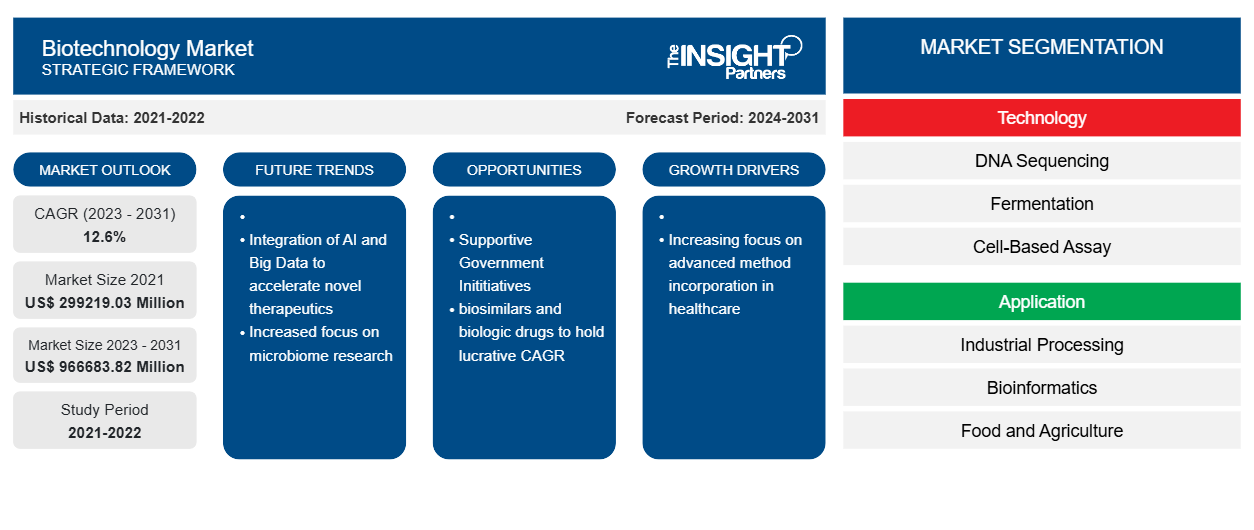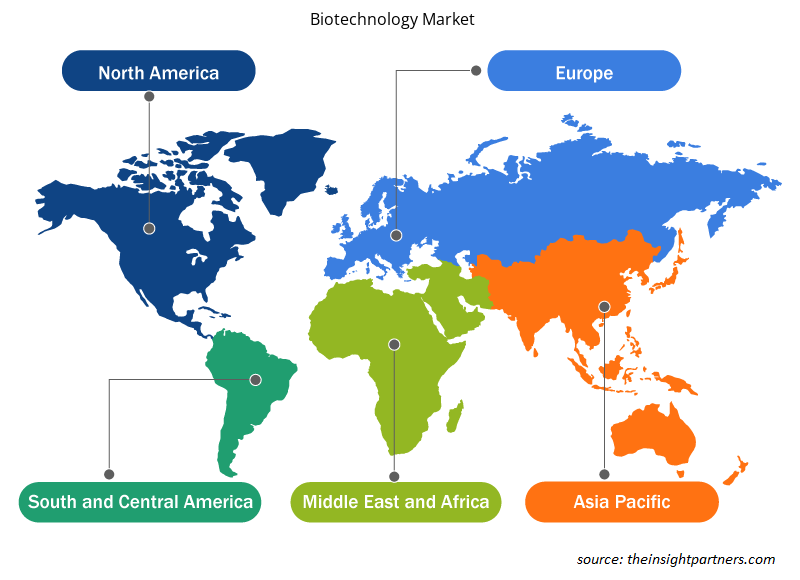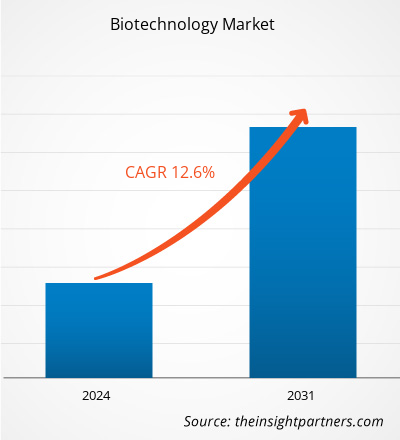The Biotechnology Market size was valued at US$ 299,219.03 million in 2021 and US$ XX million in 2023 and is expected to reach US$ 966,683.82 million by 2031; it is estimated to record a CAGR of 12.6% by 2031.
Biotechnology is applied across a broad range of sectors, including industrial bioprocessing, bioinformatics, food and agriculture, healthcare, natural resource management, and environmental protection. Modern biotechnology is driving innovation by enabling the development of advanced products and technologies to address rare and complex diseases while also contributing to sustainability by reducing environmental impact and supporting food security.
Additionally, biotechnology facilitates cleaner, more energy-efficient industrial manufacturing processes. Key market drivers include the declining cost of genome sequencing, rapid advancements in innovative technologies, and strong support from both private and public sector initiatives. The growing number of industry conferences and workshops further reflects rising interest and investment in the sector, positioning these events as important market trends likely to influence continued growth.
Biotechnology Market Analysis
The sharp decline in genome sequencing costs has been a key catalyst in advancing clinical genetics, revolutionizing the diagnosis and treatment of rare diseases, and accelerating the adoption of precision medicine. The cost of sequencing a human genome has dropped dramatically—from approximately $1 million in 2007 to $1,000 in 2014, and currently stands at around $600.
This significant reduction has made genome sequencing more accessible and is a primary driver of growth in the biotechnology market. Moreover, increasing adoption of genomic technologies by pharmaceutical and biopharmaceutical companies is further fueling market expansion, as these organizations leverage sequencing data for drug discovery, targeted therapies, and personalized treatment approaches.
Biotechnology Market Overview
Informatics experts and biologists are increasingly leveraging advanced sequencing technologies to generate more accurate and comprehensive genomic data. Recent years have seen significant improvements in software for DNA assembly and novel techniques for locating sequences on chromosomes, further enhancing genomic research capabilities.
To support the adoption of these emerging technologies, several strategic programs have been established. Notably, the National Human Genome Research Institute (NHGRI) launched the Genome Sequencing Program in 1989 to address evolving opportunities in genomics. In parallel, the Genome Technology Program is actively supporting the development of next-generation tools and instruments that enable rapid, cost-effective DNA sequencing, functional genomics experiments, and SNP genotyping. This program also facilitates technology transfer from developers to end-users, fostering multidisciplinary collaboration between academic and industrial research environments.
The market has also seen a surge in innovation from industry players. Companies like Pacific Biosciences (Sequel) and Oxford Nanopore Technologies (PromethION) have introduced cutting-edge next-generation sequencing (NGS) platforms. Meanwhile, systems such as Roche GS FLX (454), Illumina HiSeq 2000 (Solexa), and AB SOLiD (Agencourt) continue to dominate the market. These technological advancements have significantly improved the speed, accuracy, and affordability of genome sequencing.
As a result, ongoing innovation in sequencing technologies is expected to be a major driver of rapid growth in the biotechnology market during the forecast period.
The global biotechnology market is segmented by region into North America, Europe, Asia Pacific, the Middle East & Africa, and South & Central America. In North America, the US is the largest market for biotechnology. The growth in North America is characterized by an increase in the demand for innovative products from biopharmaceutical and biotechnology companies, the presence of key market players and extensive R&D conducted by various academic and research institutes. In addition, continuous technological advancements are further expected to stimulate the growth of the market in North America.
Customize This Report To Suit Your Requirement
You will get customization on any report - free of charge - including parts of this report, or country-level analysis, Excel Data pack, as well as avail great offers and discounts for start-ups & universities
Biotechnology Market: Strategic Insights

- Get Top Key Market Trends of this report.This FREE sample will include data analysis, ranging from market trends to estimates and forecasts.
You will get customization on any report - free of charge - including parts of this report, or country-level analysis, Excel Data pack, as well as avail great offers and discounts for start-ups & universities
Biotechnology Market: Strategic Insights

- Get Top Key Market Trends of this report.This FREE sample will include data analysis, ranging from market trends to estimates and forecasts.
Biotechnology Market Drivers and Opportunities
Increasing Focus on Advanced Method Incorporation in Healthcare to Favor United States Market
The biotechnology market in North America is witnessing accelerated growth, driven by the integration of advanced technologies in healthcare, a rising emphasis on precision medicine, and substantial investments in genomic research from both public and private sectors. The region has emerged as a hub for biotechnological innovation, underpinned by collaborative efforts aimed at transforming healthcare delivery, improving agricultural productivity, and enhancing industrial biomanufacturing capabilities. Precision medicine—one of the most transformative trends in modern healthcare—is gaining strong momentum in the U.S. and Canada. Government-backed initiatives, coupled with venture capital and institutional funding, are fueling research into genomics, targeted therapies, and personalized diagnostics. This growing focus is reshaping clinical practices and paving the way for tailored treatment regimens that offer greater efficacy and reduced side effects.
Medical and agricultural biotechnology have both undergone significant advancements as a result of evolving research programs and adaptive business models. Bioengineering tools, including CRISPR, synthetic biology, and molecular diagnostics, are being utilized to develop novel biomolecules, enhance disease resistance in crops, and create next-generation therapeutic products. Notably, in 2022, the U.S. Department of Health and Human Services (HHS) committed US$40 million to strengthen biomanufacturing capacity for active pharmaceutical ingredients (APIs), antibiotics, and key raw materials necessary for producing essential medicines and bolstering pandemic preparedness. This investment addresses critical supply chain vulnerabilities and supports the onshoring of pharmaceutical production. Simultaneously, the U.S. Department of Defense (DoD) launched the Tri-Service Biotechnology for a Resilient Supply Chain initiative, backed by over US$270 million over a five-year span. This ambitious program is designed to accelerate the commercialization of bio-based innovations, particularly in the defense sector, by developing sustainable fuels, high-performance materials, polymers, resins, and protective gear—all critical to national security and resilience.
These developments are further supported by an expanding ecosystem of biotech companies, academic institutions, and innovation clusters in cities such as Boston, San Francisco, and Toronto. Strong IP frameworks, advanced research infrastructure, and skilled talent pools are also contributing to the region's global competitiveness. In conclusion, North America’s biotechnology market is set to experience sustained expansion, propelled by strategic investments, cutting-edge innovation, and government initiatives aimed at strengthening both healthcare and industrial resilience. This dynamic environment is expected to unlock substantial economic value and cement the region's leadership in the global biotechnology landscape over the forecast period.
Government Initiatives – An Opportunity of Biotechnology Market
In December 2023, the Department of Biotechnology (DBT) and Biotechnology Industry Research Assistance Council (BIRAC) announced the launch of 14 new biotech-based products developed by start-ups and entrepreneurs across industries such as healthcare, diagnostics, medical devices, agriculture, industrial biotechnology, during the 3rd edition of Global Bio-India, a mega international congregation on biotechnology, held at Bharat Mandapam, Pragati Maidan in New Delhi.
Such advancements in recent years is likely to generate attractive growth opportunities for the biotechnology market.
Biotechnology Market Report Segmentation Analysis
Key segments that contributed to the derivation of the Biotechnology Market analysis are product and application.
Based on product, the biotechnology market is segmented into DNA sequencing, fermentation, cell-based assay, nanobiotechnology, chromatography, PCR technology, tissue engineering and regeneration, and other technologies. The DNA sequencing segment held the largest share of the market in 2023 and is likely to grow at the highest rate during the forecast period. DNA sequencing is a critical technique used to determine the precise order of nucleotide bases within a DNA strand. It has become indispensable in both basic and applied research, with wide-ranging applications across healthcare, biotechnology, agriculture, and forensic science.
One of the earliest large-scale uses of DNA sequencing was in the Human Genome Project, which spanned thirteen years and significantly advanced our understanding of genetic mutations linked to hereditary diseases. Today, DNA sequencing enables researchers to identify specific genes associated with genetic disorders, supporting the development of targeted therapies and personalized medicine.
Beyond healthcare, DNA sequencing is widely used in genetic testing for determining paternity and familial relationships. It also plays a key role in forensic science, helping to identify crime suspects and victims. In environmental applications, DNA sequencing assists in analyzing bacteria and other microorganisms that contribute to the contamination of air, water, and food.
Additionally, the technology is instrumental in agricultural research, helping scientists study genetic variation and migratory patterns among animal and plant species. This information is vital for identifying rare breeds and optimizing seed and livestock development.
Overall, the versatility and impact of DNA sequencing continue to drive innovation and investment across multiple sectors.
Many companies like Thermo Fisher Scientific Inc., Merck KGaA, Illumina, Inc. and various other start-up companies offer various kits and reagents for the DNA sequencing technique. Thus, the advantages offered by DNA sequencing and their use in the above applications are expected to robust the growth of the segment in the forecast period.
Based on application, the biotechnology market is segmented into industrial processing, bioinformatics, food & agriculture, health, natural resources & environment, other applications. The industrial processing segment held the largest share of the market in 2023; whereas the bioinformatics segment is likely to grow at a higher rate during the forecast period. The industrial processing or the bioprocessing market is among the most promising field of the biotechnology that is impacting the healthcare, and agriculture biotechnology market significantly and also, it’s a new approach for the prevention of pollution and conserving the resources. The industrial processing or the bioprocessing market offers business that offers lower costs and create new market by disturbing the environment. Most of the lab studies in the biotechnology are taken out for the commercial applications. The applications are used for the drug discovery and the drug development. The developments for the therapeutics human proteins are done through the recombinant methods. For instance, recombinant human insulin is the first recombinant medicine produced and was marketed by Genetech in 1982. The rise in the prevalence of the diabetes have gained a huge profit for the recombinant insulin and have significant biotechnology market growth in future. Moreover, the application of industrial processing includes the production of enzymes and micro-organisms to make bio-based products in sectors such as chemicals, food ingredients, detergents, paper, textiles, beverages, fabrics, plastics, personal care, biofuels and more.
Biotechnology Market Share Analysis by Geography
The geographic scope of the Biotechnology Market report is mainly divided into five regions: North America, Asia Pacific, Europe, the Middle East & Africa, and South & Central America.
Asia Pacific registered as the fastest-growing region in the global biotechnology market. The market in this region is expected to grow significantly in countries such as China, Japan, and India. The market's growth is attributed to the increasing focus of market players in developing economies, and supportive government policies.
Biotechnology Market Regional Insights
The regional trends and factors influencing the Biotechnology Market throughout the forecast period have been thoroughly explained by the analysts at Insight Partners. This section also discusses Biotechnology Market segments and geography across North America, Europe, Asia Pacific, Middle East and Africa, and South and Central America.

- Get the Regional Specific Data for Biotechnology Market
Biotechnology Market Report Scope
| Report Attribute | Details |
|---|---|
| Market size in 2021 | US$ 299,219.03 Million |
| Market Size by 2031 | US$ 966,683.82 Million |
| Global CAGR (2023 - 2031) | 12.6% |
| Historical Data | 2021-2022 |
| Forecast period | 2024-2031 |
| Segments Covered |
By Technology
|
| Regions and Countries Covered | North America
|
| Market leaders and key company profiles |
Biotechnology Market Players Density: Understanding Its Impact on Business Dynamics
The Biotechnology Market is growing rapidly, driven by increasing end-user demand due to factors such as evolving consumer preferences, technological advancements, and greater awareness of the product's benefits. As demand rises, businesses are expanding their offerings, innovating to meet consumer needs, and capitalizing on emerging trends, which further fuels market growth.
Market players density refers to the distribution of firms or companies operating within a particular market or industry. It indicates how many competitors (market players) are present in a given market space relative to its size or total market value.
Major Companies operating in the Biotechnology Market are:
- Novo Nordisk A/S
- Moderna Inc.
- BioNTech SE
- Regeneron Pharmaceuticals Inc.
- Vertex Pharmaceuticals Inc.
- Jazz Pharmaceuticals PLC
Disclaimer: The companies listed above are not ranked in any particular order.

- Get the Biotechnology Market top key players overview
Biotechnology Market News and Recent Developments
The Biotechnology Market is evaluated by gathering qualitative and quantitative data post primary and secondary research, which includes important corporate publications, association data, and databases. The following is a list of developments in the market for biotechnology and strategies:
- In April 2022, CytoTronics raised US$9.25M in initial seed funding, led by Anzu Partners, with the association of Milad Alucozai (BoxOne Ventures) and institutional investors. The company used this seed funding to promote its innovative platform that utilizes computer chip technology to conduct electrical and electrochemical cell-based assays (Source: CytoTronics, Press Release, 2022)
Biotechnology Market Report Coverage and Deliverables
The “Biotechnology Market Size and Forecast (2022–2030)” report provides a detailed analysis of the market covering below areas:
- Market size and forecast at global, regional, and country levels for all the key market segments covered under the scope
- Market dynamics such as drivers, restraints, and key opportunities
- Key future trends
- Detailed PEST/Porter’s Five Forces and SWOT analysis
- Global and regional market analysis covering key market trends, major players, regulations, and recent market developments
- Industry landscape and competition analysis covering market concentration, heat map analysis, prominent players, and recent developments
- Detailed company profiles
- Historical Analysis (2 Years), Base Year, Forecast (7 Years) with CAGR
- PEST and SWOT Analysis
- Market Size Value / Volume - Global, Regional, Country
- Industry and Competitive Landscape
- Excel Dataset
Testimonials
Reason to Buy
- Informed Decision-Making
- Understanding Market Dynamics
- Competitive Analysis
- Identifying Emerging Markets
- Customer Insights
- Market Forecasts
- Risk Mitigation
- Boosting Operational Efficiency
- Strategic Planning
- Investment Justification
- Tracking Industry Innovations
- Aligning with Regulatory Trends
Yes! We provide a free sample of the report, which includes Report Scope (Table of Contents), report structure, and selected insights to help you assess the value of the full report. Please click on the "Download Sample" button or contact us to receive your copy.
Absolutely — analyst assistance is part of the package. You can connect with our analyst post-purchase to clarify report insights, methodology or discuss how the findings apply to your business needs.
Once your order is successfully placed, you will receive a confirmation email along with your invoice.
• For published reports: You’ll receive access to the report within 4–6 working hours via a secured email sent to your email.
• For upcoming reports: Your order will be recorded as a pre-booking. Our team will share the estimated release date and keep you informed of any updates. As soon as the report is published, it will be delivered to your registered email.
We offer customization options to align the report with your specific objectives. Whether you need deeper insights into a particular region, industry segment, competitor analysis, or data cut, our research team can tailor the report accordingly. Please share your requirements with us, and we’ll be happy to provide a customized proposal or scope.
The report is available in either PDF format or as an Excel dataset, depending on the license you choose.
The PDF version provides the full analysis and visuals in a ready-to-read format. The Excel dataset includes all underlying data tables for easy manipulation and further analysis.
Please review the license options at checkout or contact us to confirm which formats are included with your purchase.
Our payment process is fully secure and PCI-DSS compliant.
We use trusted and encrypted payment gateways to ensure that all transactions are protected with industry-standard SSL encryption. Your payment details are never stored on our servers and are handled securely by certified third-party processors.
You can make your purchase with confidence, knowing your personal and financial information is safe with us.
Yes, we do offer special pricing for bulk purchases.
If you're interested in purchasing multiple reports, we’re happy to provide a customized bundle offer or volume-based discount tailored to your needs. Please contact our sales team with the list of reports you’re considering, and we’ll share a personalized quote.
Yes, absolutely.
Our team is available to help you make an informed decision. Whether you have questions about the report’s scope, methodology, customization options, or which license suits you best, we’re here to assist. Please reach out to us at sales@theinsightpartners.com, and one of our representatives will get in touch promptly.
Yes, a billing invoice will be automatically generated and sent to your registered email upon successful completion of your purchase.
If you need the invoice in a specific format or require additional details (such as company name, GST, or VAT information), feel free to contact us, and we’ll be happy to assist.
Yes, certainly.
If you encounter any difficulties accessing or receiving your report, our support team is ready to assist you. Simply reach out to us via email or live chat with your order information, and we’ll ensure the issue is resolved quickly so you can access your report without interruption.















- Novo Nordisk A/S
- Moderna Inc.
- BioNTech SE
- Regeneron Pharmaceuticals Inc.
- Vertex Pharmaceuticals Inc.
- Jazz Pharmaceuticals PLC
- Incyte Corp.
- Novavax, Inc.
- Vir Biotech Inc.
- BioMarin Pharmaceutical Inc.






 Get Free Sample For
Get Free Sample For